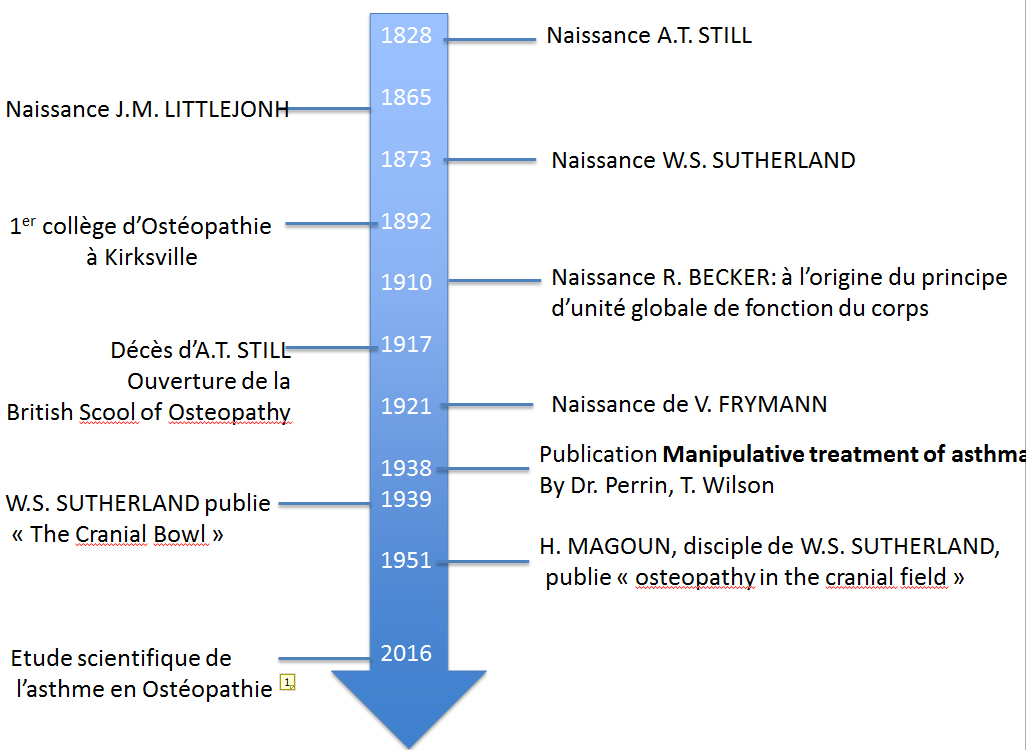Asthma and osteopathy
« To date, for the last 18 years that I have been practicing, I have never failed on an asthmatic patient. I therefore affirm that for asthma, osteopathy is sovereign. »
A.T. Still 1897 (Founder of Osteopathy)
ASTHMA
Epidemiology :
There are 1000 deaths each year in France due to asthma. It affects nearly 3.5 million French and 10 million people under 45 in Europe, 7 to 10% of children.
Asthma is a chronic inflammatory disease of the respiratory system and more specifically of the bronchi which results in a sensitivity of these “bronchial hyperreactivity” to certain stimulations. Pollen, dust mites, animal hair, stress, food allergens, pollution, tobacco, physical exertion, climatic variations and respiratory infections can be triggers. But sometimes, the triggering factor of the crisis remains unknown … It should be noted that 80% of asthmatics suffer from allergic rhinitis.
This bronchial hyperreactivity involves:
- Bronchospasm: a contraction of the bronchioles, thus causing a narrowing of the passage of the air (1st cause of bronchial obstruction).
- Bronchial hypersecretion: the inner lining of the bronchioles will ignite and secrete mucus (2nd cause of bronchial obstruction)
- A dry cough: To clear his bronchi, the patient coughs with a dry cough.
As many reactions result in asthma attack.
The breathing becomes wheezy, accompanied by shortness of breath and sometimes a feeling of tightness in the chest. To clear his bronchi, the patient begins to cough with a dry cough. During the crisis, breathing, but more especially expiration of air in the lungs, are more difficult, as if the air circulated in a thin straw.
An asthma attack is often preceded by warning signs, which are different for each asthmatic. However, they rarely vary in the same person.
Symptomatic drug treatment:
The drugs can then improve breathing by limiting inflammation and obstruction of the bronchi because lack of conventional medicine to identify its cause, the treatment remains symptomatic and requires, sometimes for life, the taking of drugs if the we do not want to suffer an exhausting and oppressive respiratory discomfort.
What would be the cause of asthma?
Osteopathy brings a new way of thinking.
According to official medicine, the main factor at the origin of asthma are hereditary, allergic or infectious. An infection of the respiratory system will weaken the tissues, thus promoting their inflammation (80% of asthmatics suffer from allergic rhinitis). But a distinction should be made between “triggers of asthma” mentioned above and the real cause of asthma. Official medicine tells us that the cause of asthma is unknown. This is where osteopathy can bring new
Inflammation of the bronchi is the basis of asthma.
However, isn’t all inflammation a “normal defense of the body” in response (albeit exaggerated) to real or perceived aggression or an attempt to repair it?
And to really understand the origin of asthma, (i.e. its cause), wouldn’t it be a better approach to look into the factors that led to the inflammation rather than on the inflammation itself in order to identify the origin of asthma ? Is this not where the supposed cause of asthma must be found? What makes certain stimuli in some people provoke this kind of reaction while that the same stimuli do nothing to others? Is there no reason to wonder why this answer is different?
This question has opened to holistic osteopaths a path of reflection that allows them to overcome asthma attacks.
Osteopathic approach
« It is necessary to have a solid knowledge of the spine, because many conditions are indeed caused by a defective state of this organ. »
HIPPOCRATE De articulis § 45 (435 BC)
How many sessions in total and after how long are we entitled to expect results?
Treating children with asthma in osteopathy gives spectacular and lasting results, most of the time in one to two sessions.
For adults, it takes a little more perseverance and obstinacy but 4 to 5 sessions can largely be enough to completely eradicate asthma.
This requires that the patient be careful not to ‘re-lock’ his spine after the sessions which would invalidate positive effects of the treatment. So-called postural hygiene measures must be adopted by the patient (the patient must take care of himself) in order to avoid that symptoms reappear.
(Click on this link below to know them)
How can osteopathy achieve such results?
Asthma is an “expiratory difficulty”, (normal inspiration but wheezing exhalation). The “inspiratory difficulty”, characterized by wheezing and normal exhalation, is as common and disabling as “expiratory difficulty” but is considered “false asthma”. Doctors and patients do not always make the difference because between the two, often treatment is the same, although it is known that taking bronchodilators (Ventolin) is much less effective on “inspiratory dyspnea”. Indeed, expiratory difficulty (true asthma) is due to a bronchial spasm (intrathoracic) while inspiratory dyspnea is caused by a pharyngeal spasm (extra-thoracic, hence the name “false asthma”). The treatment will not be the same because the blockages inducing these two types of asthma are not the same. Bronchial spasm (true asthma) is generated by blockages located mainly in the first 3 thoracic segments (or stages) whereas pharyngeal spasm (false asthma) is due to a high cervical blockage C0 / C1 / C2.
In Osteopathy, we consider the patient as a whole. The body is a unit that suffers influences of different origins: psychological, environmental and physical. These influences will cause musculoskeletal responses (joint blockage) in the body.
Therapeutics must therefore take into account all the disturbances of the body diagram, the associated emotional and visceral disorders, the sensitivity of each person, the use he makes of it, the neuro-motor reprogramming or proprioceptive education if necessary, the correction of a defective power supply, tooth rebalancing, fitting …
What happens to the asthmatic subject?
It is remarkable to note that we find almost systematically the same blockages (well-defined specific mapping) in all asthmatic patients. There is therefore a parallel between the localization of blockages at the cervical and thoracic level and a particular expression of asthma. A well-defined cartography of the blockages of the thoracic cage and the very precise cervical region is proof of this. It is these blockages that will eventually lead to the asthma attack. It should be noted that although these blockages are systematically present in any person suffering from asthma, it is not uncommon to find these same blockages in people without asthma. This suggests that there is another factor (still unknown) concomitant blockages for the pathology can be expressed. A notion of terrain could possibly be considered.
What we find as blockages (as well as variations) in asthmatics:
In true asthmatics, that is to say those suffering from expiratory difficulty and not inspiratory, we will have a predominance of blockages on the right, responsible for an overall retreat of the entire upper part of the right hemi-thorax ( costal posteriorization visible to the naked eye of the right hemi-thorax). In subjects with false asthma, that is to say having an inspiratory dyspnea, blockages will be indifferently sometimes right or sometimes left, sometimes even bilaterally and will be accompanied systematically (very specifically) cervical blockages C0 / C1 / C2 characteristics of this state. These are all blockages that will be responsible and eventually lead to the asthma attack.
The distribution and combination of all these blockages among them will define and distinguish the predominance of asthma. A blockage in the first thoracic stage will reflect the allergic aspect of the person and therefore characterize predominantly allergic asthma; in the second thoracic stage, asthma has a greater secretory component, and on the third floor, asthma has a greater broncho-constrictive component. We can see that depending on the size of the blockages, their precise location and combinations, we will face a different variety of asthma.
All this is explained by the fact that each vertebral stage is responsible for the innervation of a particular territory that corresponds to it [muscular (myotome), articular and ligamentous (sclerotome), cutaneous (dermatome), vascular (angiotome) territory, visceral (viscerotome)]. When a blockage is present, it will have a disruptive effect and will generate an excessive discharge of nerve impulses at the level of the metamère, thus lowering the threshold of sensitivity (increase of the irritability) on all the corresponding metamerican territory, which will result in hyperactivity of the region concerned, which, in the case of the visceral territory (in this case the bronchi), will cause bronchial hyperirritability at the origin of the asthma attack. It is the same for the cutaneous territory causing this time a deregulation in the skin (for example: eczema or psoriasis).
As we see, everything is played primarily at the level of the first 3 thoracic stages and the upper cervical region.
A mechanical phenomenon: the liver
Importance of the influence of the liver / diaphragm pair on the blockages of the thoracic cage or the indirect role of the diaphragm in the genesis of the torsional process of the thoracic cage.
The explanation of osteopaths:
The diaphragm is the most powerful muscle of the body and it is thanks to its contraction that the entry of the air into the lungs and its relaxation that we have rejection of this same air to the outside. But the main obstacle to the proper functioning of the diaphragm (alternation of contraction / relaxation) is due to the presence of the liver, the largest organ of the body, which is suspended under the two-thirds of the diaphragm. Flexible when the body is healthy, its density can increase in case of functional insufficiency and thus limit the amplitude of the diaphragm. The increased density of the liver creates traction under the right diaphragmatic cupola which causes a rotation of the thoracic cage (posteriority [recoil] of the right hemi-thorax and anterior left shoulder). Remember that the diaphragm attaches to all the inner and lower edges of the ribs.
The anatomical displacement of the shoulder increases the tension of the muscles that connect the shoulder to the cervical vertebrae and mainly the scalenes. However, the scalenes are precisely the accessory respiratory muscles that are stressed when the amplitude of the diaphragm is mechanically limited.
Stellate ganglion involvement
In addition, through these muscles pass the arteries that vascularize the stellate ganglion, precisely responsible for the regulation (through the orthosympathetic system) of the size of the bronchi, bronchial secretion (responsible for bronchial congestion) and coughing. (responsible for the reflex of irritative cough). It is also a kind of small information center that informs the brain of the state of the cardiorespiratory system, the possible presence of a danger, in order to make the body’s defense system react ( inflammation). In the case of asthma or allergy in presence of a foreign body: pollen, tobacco, mites, animal hair …), the stellate ganglion, disturbed by its poor vascularization or compression due to thoracic torsion, will be irritated (irritating thorn) and send to the brain parasitized messages (medullary facilitation) that will amplify the response provided by the brain (outbreak of an asthma attack).
This is how the osteopath manages to improve or even stop an asthma attack by releasing the first three ribs on which the scalenus are fixed. The relaxation of the muscular tension releases the arterial flow and lifts the compression exerted on the stellate ganglion.
The information it transmits to the brain is no longer parasitized and will trigger normal reactions this time, increasing the immune defenses (dilation of capillaries, regulation of nerve impulses and evacuation of excess mucus). The effect is immediate in young children whose acidosis is not yet important.
Upstream, let’s treat the liver
The liver is an omnipotent organ that is involved in all functions of the human body. It is therefore normal that it is involved in asthma attacks, which involves taking into consideration in all treatments the factors likely to lead to liver failure.
Increased acidity in the body due to liver malfunction:
The increase in the density of a liver is observed when it is loaded with fats. When the liver is fat, one speaks in medicine of steatosis. The liver stores the glucose reserves, energy source of our cells. In case of insufficiency, instead of releasing glucose into the blood, it turns it into fat.
This transformation produces an increase in acidity in the body that is naturally eliminated by the kidneys (urine), skin (sweat) and lungs (carbon dioxide). The carbonic acids are transformed into carbon dioxide and water. They represent 90% of the source of acid in the body, which highlights the permanent role of the lungs to regulate the acid-base balance of the body. Thus, poor metabolism due to liver failure, would produce an overproduction of acid that would affect the functioning of the lungs.
The results are less rapid in those who digest poorly milk and in vegetarians, because the volatile acids come mainly from the transformation of vegetable proteins and milk.
Other cause of torsion of the rib cage and durability of blockages at the thoracic level
- Key points (blockages) in the thoracic torso wall (source of chest blockage)
- The imbalance of the pelvis due to an asymmetry of muscular tension (pelvic inclination at the origin of scoliotic compensation of the thoracic cage).
Blocking of the 9th dorsal vertebra: key point that keeps torsion in the rib cage maintaining blockages at the level of the rib cage
Palpation pain in the ninth dorsal vertebra also confirms hepatic origin. These pains are in fact the projection of the tension of the diaphragm on the ribs which is transmitted in the back on the vertebral joint.
It is a real vicious circle, because the tension of the diaphragm compresses a large artery coming from the heart which distributes the blood in the lower part of the body. But it is precisely the liver that requires the greatest amount of blood.
In addition, sympathetic neurovegetative ganglia that, like a transformer, control the nerve impulses that drive the liver, are compressed at the level of the ninth dorsal vertebra. Poorly vascularized and poorly innervated, its functions are insufficient to ensure the proper metabolism and produce acid.
The imbalance of the basin
This mechanical lesion is always associated with an imbalance of the pelvis. The explanation is as follows:
The pelvis is balanced by two muscle stays that start from the hips to attach to the lumbar spine. The location of the liver and duodenum, part of the digestive tract where food is digested by enzymes, is on the right side of the abdomen. Their dysfunction creates anatomical tension in the abdomen that compresses the arterial branch that distributes blood to the muscle stay that stabilizes the right hip.
This is a perfect example of the application of both laws as stated by Still (the founder of osteopathy)
“The structure governs the function” that is to say that the structure depends on the function hence the need for a normal structure for a normal function (respiratory function).
But also “The human body contains or is capable of producing the substances and mechanisms necessary for both its self-defense and the maintenance of its health.”
The mode of action of osteopaths (therapeutic protocol)
Holistic osteopaths integrate all these notions. The drainage of the liver releases the amplitude of the diaphragm, the left shoulder is repositioned. The so-called “neuro-vascular” manual techniques release the tension of the scalenes in order to restore a good local circulation (remember that 80% of the arteries pass through the muscles). The osteo-articular lesions at the level of the first three ribs rise, the decompression and the best vascularization of the stellate ganglion restore all its functionality. It transmits the information to the brain that triggers the defense system to restore a normal caliber of the bronchioles. This mechanism explains the action of some reflex osteo-articular techniques, which however remain insufficient for long-term results in cases of body acidosis.
It is often found from an articular point of view but also muscular and tissue:
- A blockage of the first four thoracic, especially right (true asthma)
- A short leg to the right
- Cervical blockage of C0 C1 C2 (false asthma)
- A general postural imbalance that must be treated: feet, pelvis, thorax, ribs and ground support.
Asthma is due to blockages; the main points treated in osteopathy are:
- Chest blockages (sympathetic correspondence), especially thoracic Th1 to Th4.
- Cervical and cranial blockages (parasympathetic correspondence) (nerve X).
- The blockages at the level of the attachments of the lungs, thus work of the thoracic fascia and the diaphragm.
- Problem of mechanical attachments (asymmetry of muscular tension leading to a postural disorder).
Asthma and eczema are often linked:
In general, asthma is a recurring problem, which can occur before or after eczema (communicating slime effect: when asthma disappears, eczema appears and vice versa). This is easily explained because it is known that the costo-vertebral blockages responsible for disturbance in cutaneous and visceral metameric territories that sometimes give eczema, sometimes asthma, are the same. As a result, it is often noted that when asthma disappears, there is often a small return of eczema before everything returns to normal after treatment.
And for the skeptics, remember what Still said:
To those who claim that the manipulation of the skeleton has no impact on the organic functions, we answer that they simply did not make the painstaking, sometimes painful, learning of the art of reharmonizing the relations of the structures of the body.
Still
And also what Hippocrates said:
“The skillful and conscientious physician must be clever at his sight as well as his hand when it comes to correct the vertebral deviations of the patient lying in front of him on the treatment table.”
HIPPOCRATE (435 BC)
As we know, asthma is regulated by medications, which although never harmless, save lives. But for conventional medicine to identify the cause, the treatment remains symptomatic and sometimes requires lifelong medication. Osteopathy, meanwhile, tries to explain the mechanism of asthma and also tries to provide a causal solution.
Causes of asthma from an osteopathic point of view (neurophysiological explanation)
Everyone controls his muscles, his movements, his speed of action, his precision. But there are things that are automatically controlled by the sympathetic and parasympathetic systems (also called vegetative or neurovegetative). These systems (the parasympathetic nerve X and the costal sympathetic system) control the heart, the liver, the stomach, the spleen, the pancreas, the intestines, almost all the viscera, the corresponding skin, the joints of the same zones. Therefore, neither the organs, nor the skin, nor the irrigation, nor the possible blockages of the articulations are controlled by the will. You cannot order a joint: “slide right, a little forward, go up, turn to the right, compress yourself, unlock yourself”.
The sympathetic and parasympathetic systems are 80% sensory and 20% motor, which is to say that 80% of the neurovegetative nerve fibers provide sensory information to the brain (all cells of the body send him information permanently) and only 20 % of neurovegetative nerve fibers return motor orders.
All sensory peripheral information reaches the marrow and eventually the brain and if necessary, it returns in the form of motor information, passing through the sympathetic neurovegetative ganglia that are under the ribs.
When everything goes well, the answer is appropriate. The information emitted by an organ normally arrives at the marrow which transmits it to the higher centers of integration of the brain; the information is analyzed so that an adapted response is sent back to the organ.
But, when a vertebral block comes to parasitize this information, (the metamer is said to be “facilitated” because “hyper-solicited”), the answer will be inappropriate: excessive, disproportionate, without any relation with the initial information emitted by the organ in question. The organ in turn reacts inappropriately, becoming “hyper reactive” and “irritable” By igniting, it creates a different pathology depending on the organ or tissue damaged, but the origin of the dysfunction remains the same . (According to Irwin Khor).
The excessive response will be manifested in the bronchi by asthma, in the skin by eczema or psoriasis, or on any other part of the body (specifically) as, for example, the eyes or the nose by allergy, depending on the metameric facility concerned, in this case the viscerotome (in case of asthma) or the dermatome (in case of cutaneous pathology) etc. …
If we return to the bronchi, because of the combination of vertebral and rib blockages (which implies that the marrow returns a disproportionate response in the bronchial tubes), the pathological response will result in the form of asthma. The bronchi become more reactive, more irritable, hypersensitive to increase the system of defense of the body, then follows a hyper inflammation of the bronchi, an irritative reflex cough, a constriction bronchitis, in short asthma!
Moreover, we realized that in case of asthma, the chest blockages were more easily on the right with a rocker of the pelvis also on the right showing a false short leg on the same side (right), while in the presence of psoriasis, the thoracic blockages will be located on the left, with a pelvic tilt on the left as well, and a short false leg on the same side (left). It is for this reason that when one rectifies the asthma, the eczema (if it had existed) can reappear before disappearing completely.
Osteopathic method
As early as 1878 A. T. Still, (founder of osteopathy), claimed to cure asthma with “success”
“For 18 years that I have been practicing, I have never failed on an asthmatic patient. I therefore affirm that for asthma, osteopathy is sovereign “
A.T. Still declared in 1897
Since then, many osteopaths have continued to study the subject, participating in its evolution and contributing greatly to improve its clinical application. We benefited from their teaching to which we added our own reflection.
A short history of the treatment of asthma by osteopathy:
About the book “Osteopathy: Research and Practice” (Sully Eds, 1910)
Ultimate work by Still, it is considered both as a summary of his osteopathic journey and a legacy left to his successors. The father of osteopathy explains to us his way of reasoning and theorizes his conception of all the different parts of the body, as well as their functioning, to which he proposes his treatment when they present a disorder.
« Osteopathy is based on the perfection of the work of Nature. When all parts of the human body are online, we have health. When this is not the case, the resulting effect is the disease. When the parts are readjusted, the disease gives way to health. The job of the osteopath is to adjust the body from abnormal to normal; then, the abnormal condition gives way to normal, health resulting from the normal condition”
A. T. Still
Preliminary remark:
Our knowledge in the fields of biology and physiology has seriously evolved since the days of Still, some statements seem today obsolete, even erroneous. However, the reasoning is still consistent. He gives us at every page a wonderful lesson in osteopathy
Here is an excerpt from A. T. Still entitled “Osteopathy: Research and Practice”, published in 1910, in which he explains very clearly how he does it:
(Click on the link below to read the passage from the book)
Asthma by A. T. Still From “Osteopathy: Research and Practice” 1910
Here is the passage from his book dedicated to the Thoracic Region where Still explains his way of reasoning as well as how to treat all the pathologies related to it. (Click on the following link to read the excerpt)
Thoracic Région By A. T. Still From “Osteopathy: Research and Practice” 1910
His successors and students, Dr. Perrin and T. Wilson, continued his work well after his death by managing to continually improve the treatment protocol and by regularly publishing in the JAOA their advances in very detailed articles, as early as 1938 (and then in 1945 and finally in 1965), thus testifying to the progress of the method and the proof of its perfect effectiveness on asthma. To satisfy your curiosity and your interest on this question, here is a selection of these articles, which will not fail to fascinate anyone who seeks to find new keys, to better understand the factors involved in this disease and thus help patients who suffer from this affection, strong of answers which proved the effectiveness, vis-a-vis a pathology whose causes remain stilladays subject to discussion. His texts, which have not lost a single wrinkle, remain very instructive resources for practitioners of yesterday as for us, caring today. For more than a century, our predecessors have placed a major emphasis on the treatment of asthma, which is already rife in the population. (Click on the following links to read the texts)
Manipulative treatment of asthma By Dr. Perrin, T. Wilson (JAOA Year book 1938)
The osteopathic treatment of asthma By Perrin T. Wilson D.O. JAOA Year book 1949
The osteopathic treatment of asthma By Perrin T. Wilson D.O. JAOA Year book 1965
EARL J. DRINKALL, D. O. he, too, has contributed effectively to advance the cause of asthma by publishing in 1941 in the JAOA an article explaining his own technique to treat the asthmatic subject: (Click on the following link to read the article)
Manipulative treatment of asthma By EARL J. DRINKALL, D. O. ( JAOA Year book 1941)
The striking thing about reading these articles is that everything was already written at the beginning of the last century, and that from the birth of osteopathy. Knowledge about the treatment of this pathology has not changed much but, above all, it is curious to realize that despite their more than promising efficacy, these treatments have not been really followed or applied by the osteopaths. Thus, while everyone would benefit from being informed of the enormous potential of osteopathy to fight against the consequences of a pathology such as asthma, it is none the less. This “know-how” seems to have been – voluntarily or not – forgotten or lost and we rediscover that today’s relevance.
Since it works so well, why this amnesia for so many years?
It is likely that the difficulty of asserting our work with the institution, and especially with the official medical authorities, has something to do with it. Many have difficulty understanding our work and, therefore, remain skeptical about the appropriateness of our treatments, which they find inadequately evaluated, when not potentially dangerous.
It is also true that our profession was not organized collectively around this theme, and that we are not many to fight so that the treatment of asthma in osteopathy is recognized at its true value. It is even likely that even within the profession, a number of osteopaths not only do not know how to treat asthma, but are not even aware that osteopathic asthma treatment exists. Moreover, from experience, we are not much to talk about it or to disseminate information. Those who risk it are often misunderstood and misunderstood, when they do not pass for eccentrics, despite the excellent results obtained, accumulated for years, then relayed by our patients who thank us by fully moving the mouth to hear.
Why is it so bad to say that you can treat asthma? Or, rather, why are so many people so skeptical?
The attacks that we hear most often are:
- The absence of scientific evidence, especially of clinical studies:
The reproach that is most often addressed to us remains the absence of scientific evidence (as defined by the medical protocols), and especially of clinical studies, (answering the methodology that is authentic in the medical lexical field) , which seem inevitable to make us audible, even credible without having to fight against the a priori.
It is true that if we ever want our approach to be recognized, it would indeed be desirable to publish a study in a medical journal recognized for its seriousness in science; however, obtaining a scientific publication seems an insurmountable test to any osteopath who does not belong to the medical community (not a doctor). In addition, most studies are selected or solicited by the pharmaceutical industry; however, no laboratory will be interested in supporting osteopathy or even talking about the financial side.
In any case, if we manage to publish, which is desirable, our studies may be criticized, as is customary when any study is published; but, at least, we will embark on the right path. Because it is up to us to demonstrate the relevance of our profession to doctors who may not have had the opportunity to enjoy a peaceful dialogue on this subject, which allows them to go beyond a priori on osteopathy. conveyed by society in general as well as by medical professors in particular. It is the prerogative of minority approaches to have to fight side by side to make themselves heard by the sciences established by the institution for millennia, to finally succeed in making a place for them. Some methods that were not granted in hospitals, such as hypnosis or acupuncture 20 years ago, and which were subjected to criticisms comparable to those made to us, ended up convincing, by force to fight for the legitimacy that was not granted them.
Any therapy in medicine is the subject of medical studies, if only to be validated. That’s why we decided, Catherine Rod de Verchère and myself, Karl-Frédéric Richard, both osteopaths specialized in the treatment of asthma in osteopathy since the year 2000, to carry out this study. to test the effectiveness of our “osteopathic” method on asthmatic patients. It takes time and means. We have been fighting for more than 5 years to get there. Of course, we will not fail to keep you informed as this study unfolds. See Asthma Study tab “click on this link”
To understand the difficulties we encounter in evaluating our work, let us remember that osteopathy is a set of osteo-articular techniques. The experimentation that is used in medical studies to validate a clinical experiment is that called “double blind” Or our studies are partly biased by the difficulty of performing a double-blind experiment (the practitioner knowing which method he uses, he can not be double blind). On the other hand, it must be ensured that the patient’s evaluation or the analysis of the observed results is carried out at least blindly, by an outside observer or an operator who is not the therapist, and who must not know to which group the patients belong to.
In addition, the simple manual contact, with tensioning without manipulation, involves cutaneous sensors which are known to be of major importance in the implementation of any reflexotherapy (neurological arc). The manual therapeutic approach is essentially empirical. Many theories explaining their mode of action are advanced, but their evaluation can only face the difficulty to implement a placebo technique in a double-blind study without body contact. Currently, it is accepted that cutaneous techniques involve the nerve structures of the dermis and hypoderm, as most reflexotherapies, such as acupuncture, whose stimulation of the points, which have a physical and histological reality (neuro complex -vascular), involves specialized receptors involved in the regulation of the nociceptive message (gate control Melzac and Wall) it is also admitted that this stimulation also leads to the production of neuromediator, as demonstrated by the serum transfer experiments of acupuncture analgesia.
However, it is possible to use control groups receiving non-specific manipulations (having no therapeutic action on asthma) to which one can, if necessary, add a third control group which would receive no manipulation. By comparing the “specific manipulation” and “non-specific manipulation” groups, or even the “no manipulation” group, it can be determined whether the method is more effective than simple manual manipulations performed on the patient. The method is not perfect, but it has the advantage of having proved its good results. It is common in medical research not to be able to use a double-blind method for practical purposes. In this case, it is accepted in medicine to apply protocols that are close to double blind without being able to apply this method in the strict sense of the term.
At present, our best “scientific” validation remains the satisfaction of our patients, (although unfortunately it has not the slightest scientific value). This is the reason why many testimonials, which we call patients to extend the list on this site, will quickly corroborate our statement. I am well aware that these are only “special cases”: nevertheless, we can draw from the neutrality of these stories, indications of their effectiveness and this, even if these testimonies are purely informative and do not claim to be worthy of proof.
- Another subject of controversy, the famous “if it existed, it would know”
And the argument invoked to justify this criticism: the fact that we have only a few anecdotal cases to present. It is true that, whatever the treatment, there will always be a person to affirm, in good faith, that this treatment was the only one to bring him healing. It is difficult to deduce from this that this treatment works. From a scientific point of view, nothing can be concluded from a particular case.
This criticism was particularly heard when we tried to make contact with the pneumologists we asked for to participate in our study of what we are doing. Those of them who did not refute the efficacy of our treatment, however, assimilated our successes to a few isolated cases; nothing illogical about this, we are not yet numerous enough for the number of patients to act as proof and alert the doctors concerned.
- Another criticism heard “From the moment we do not understand how your method works, we can not believe in its effectiveness”:
I hope this site will provide enough satisfying explanations to anyone who will try to understand what we are doing. I am also ready to contact via the forum or by email with anyone who will express the need, to answer any questions that you want to ask me.
To conclude this chapter and in order to finish on a positive note, I would very much like, in the near future, to establish a real dialogue between our two professions (osteopaths and pulmonologists): I think we have a lot to bring to us. one, the other; Thus, we could seriously consider opening osteopathic clinics specializing in the treatment of asthma, based on the cordial understanding between our two professions – this would be both an unprecedented multidisciplinary care offer offered to patients, as well as a first interdisciplinary experiment of this kind in France.
« The art of manual therapy is old: I hold in high esteem those who discovered it as those who generation after generation, will succeed me and whose work will contribute to the development of the natural art of healing. »
HIPPOCRATE (435 BC)
A protocol specific to the method
Since Still, the founder of osteopathy in 1878, many osteopaths have thought about the issue of asthma. We benefited from their teaching to which we added our own reflection.
The protocol we have defined benefits from all the experience and methodology of the osteopaths who preceded us and draws its substance from the substantive substance of the fundamental principles elaborated by Still.
This very specific technique is not learned in schools of osteopathy but taught postgraduate courses in specific courses, this is the reason why any osteopath is not qualified to treat this kind of pathology s he did not learn it.
The asthmatic patient always presents the same types of lesions that are responsible for his asthma.
The patient is as follows:
- At the cranial level:
- At the level of the thorax:
- At the abdominal level:
- At the basin level:
It is because we know exactly which lesions are responsible for his asthma and that we know how to treat them, that we can be effective for sure.
This protocol is to use very specific techniques on specific areas in a well-defined order
List of techniques used:
- Clavicle equilibration
- Equilibration of the pericardium
- Release of the liver and diaphragm
- Central tendon; tendinous lamina: OTTP (Occipito-thymo-thyro-pericardial lamina)
- Cervical hinges, dorsal
- Dorso-lumbar hinge
- Lumbosacral hinge
- Balanced basin
- Balancing of the column
- Equilibration of the rib cage
- Balance of the lower limbs
Instructions
The goal is to preserve as long as possible the benefit of osteopathy sessions, by preventive advice.
You must be motivated and follow the recommendations to the letter.
These are LIFE HYGIENE RECOMMENDATIONS
Postural hygiene is essential to maintaining the improvements that can be seen after treatment. Otherwise, we lose everything in a few days.
NB: It is not advisable to interrupt medical treatment before the doctor decides it.
In summary
The recurrences are always possible, it is then necessary to remake the point with your therapist if the symptoms reappear.
This is often the case because of the incorrect application of the instructions:
- No postural hygiene
- No hold hold
- Traumatic shock
- Repetitive movements
- Heavy loads
An annual check is necessary to maintain its balance.

Standing position
Never in support position on one legSTANDING POSITION
Never be in the support position on one leg
Evenly balanced with your body weight equally distributed between both feet. Watch your tendency to rest on one leg!
If this is the case, your pelvis is not level, it gets out of order or the practitioner has forgotten to stall a small short leg (it can be a single millimeter and cause this support reflex).
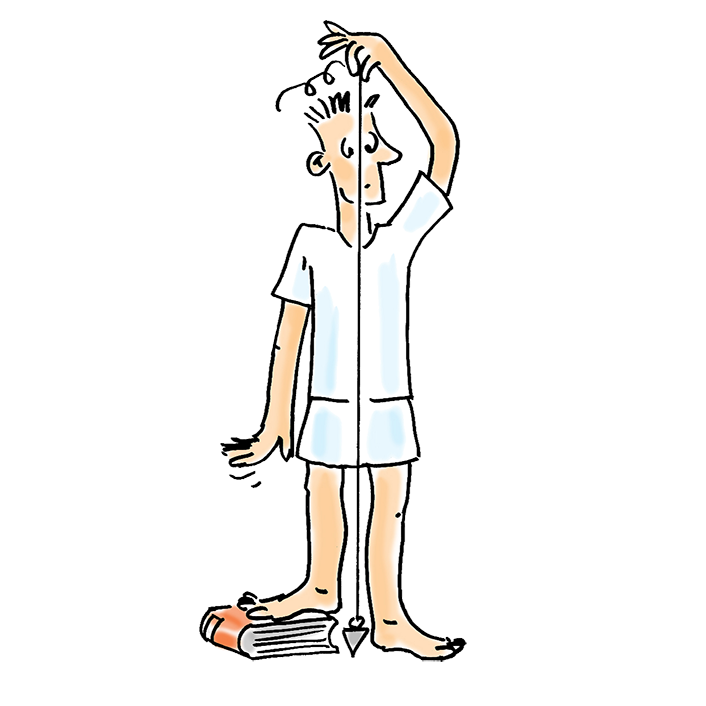
If wearing a heel
Keep it permanentlyIF PORT OF A TALONNETTE
Keep it permanently
It may take temporary bridging in case of a false short leg while waiting for the rebalancing of the posture.
The pond should always remain perfectly level (horizontal).
This precaution applies upright but also lying and sitting.
.

Sitting position
Do not wallowSITTING POSITION
You must not wallow on the sofa TOO LOW, fully rounded back
It is necessary to arch the lumbar to avoid wrapping the shoulders forward.
ALL these positions of collapse are to be avoided because they cause a fixed posteriorisation of the upper costal grill (origin of the problems of asthma and allergies, etc.).
The thorax can not develop in this folded position.

IDEAL WORKING POSITION
In front a computer for exampleIn front of a desk
Ideal position to work in front of a desk
Sit with the two bones of the buttocks (ischions) well placed evenly on the front of the chair, without using the backrest.
Stand straight without crossing your legs.
Relax your shoulders.
Hold your forearms and wrist with your hand so that you do not have stiff shoulders.

Sleeping position
Do not sleep on your stomachSLEEP
To sleep, imperatively remove the position on the belly
Because the neck will be forced on one side during the whole night. It is therefore best to sleep on your side, without torsion, or on your back, with a pillow to keep your head in line. The head should not be tilted to the mattress or tilted upwards.
Do not read lying on the side in support on the elbow with the head on the hand
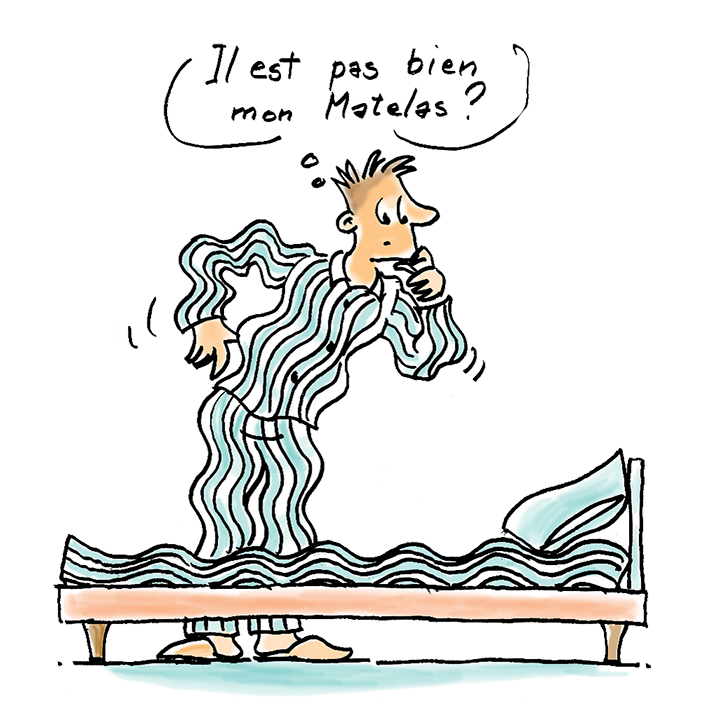
The mattress
Change it regularly, every 5 yearsTHE MATTRESS
It is important to change the mattress regularly, every 5 years.
A mattress of more than 5 years has the irreversible imprint of your body. As you ALWAYS lie down in the direction of your lesions (if a cervical can not turn to the right without being “unpleasantly” perceived, you will always lie head turned to the left to “be” well) the mattress will take your imprint in which will make you feel comfortable to fall asleep.

Carrying heavy loads
Avoid wearing your bag on one shoulder, preferably use a suitcase on wheelsPORT OF HEAVY LOADS
It is difficult not to destructure while carrying loads, so it is in your interest to reduce any tension and muscle pain felt on one side of the body.
For this, avoid carrying your bag on one shoulder. The right and left sides must be balanced to distribute the weight. Use preferably and obligatorily if the weight justifies it, a suitcase with wheels. Use a shopping cart and not a shopping cart to take your shopping off the market.

THE SHOES
Nothing soft under your feetSHOES: NOTHING SOFT UNDER YOUR FEET!
It is therefore necessary to wear sports shoes only for sports! The rest of the time, you should wear normal street shoes with a leather base, instead of this foam base. Shoes should not have a soft, but firm sole.
.
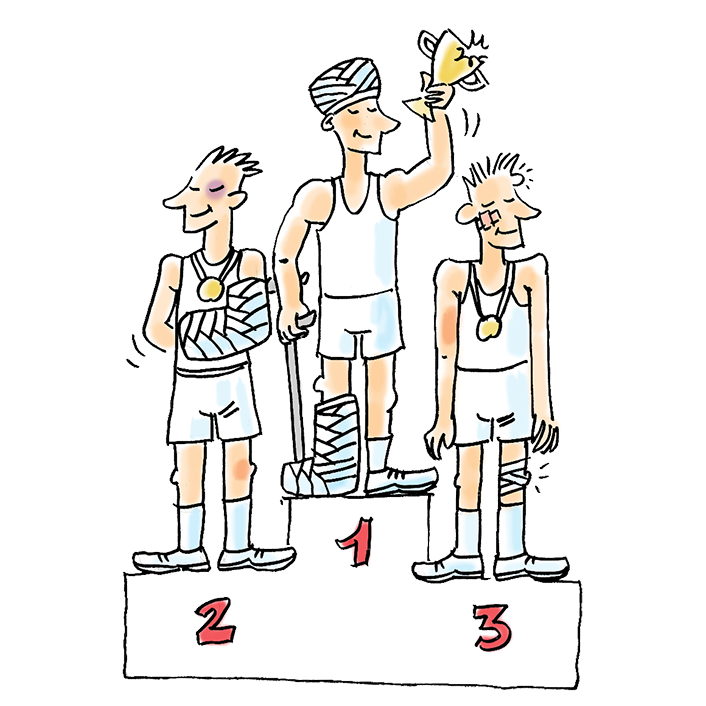
The sport
It must not become a cause of destructuringTHE SPORT
It must remain acceptable so as not to become a cause of destructuring!
Muscle, okay but not on a body unstructured where this bodybuilding became important, will fix the problems. You can practice everything with a well-balanced body,
FORCED LABOR
Avoid twisting movement and try to always be perfectly alignedWORK
For people doing heavy work, it will be difficult not to destructure!
They will have to think of their actions to avoid any torsional movement and try to always be perfectly in line, before lifting a load.
.
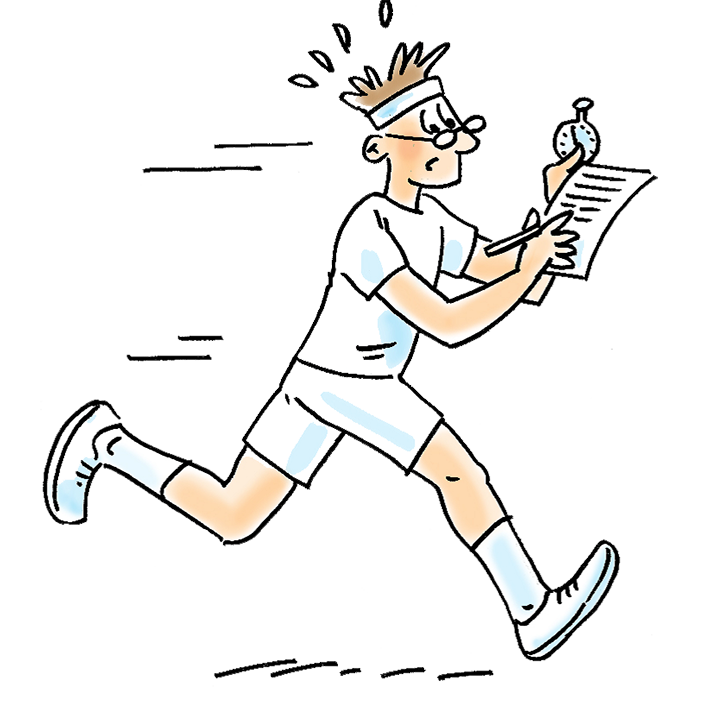
When to schedule a session of osteopathy?
After a violent shock, or at the end of the seasonSchedule a session of osteopathy after a violent shock, or at the end of the season for contact sports.
Accidents, falls are an opportunity to be verified because it is roughly 5 years after the destabilization that pathologies will appear. For everyone, a control visit once a year would be wise.
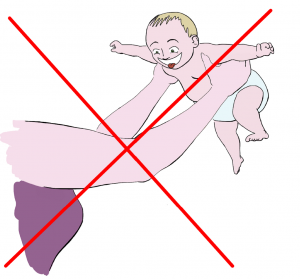
Do not lift your baby by the thorax
Lifting a baby by the thorax is strictly forbiddenABSOLUTELY DEFENDED to lift your baby by the thorax
Be especially careful not to lift your baby by the chest, under his armpits, there is nothing better to destabilize a chest because all the weight of his body is supported on your thumbs and crush his first ribs.
Contrary to what one might think a small child’s thorax is very fragile!
.
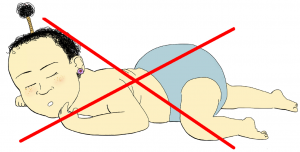
Do not let your baby sleep on his stomach
ABSOLUTELY DEFENDED to make him sleep on his stomach
Do not let your baby sleep on his stomach to keep the osteopath’s work of balancing out of the cervical rotation that makes him cough. If the baby’s body is twisted, he will recover in the direction of his injuries to relax and fall asleep. Give him a small square pillow to support his head in the axis of the body when he lies on his side.
.
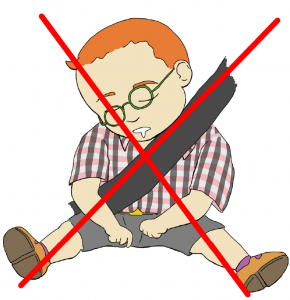
During the trips
Have them wear a small foam braceDURING TRAVEL BY CAR, BY TRAIN, BY PLANE
The best is to wear a small neck brace foam or chock the head with cushions laterally. The head is so heavy compared to the musculature of the neck, which can be completely relaxed by sleep, that the cervical are suffering during the car trips.
.
.

CHILDREN
They must be seated properlyA SCHOOL OR AT HOME
At school, children are not sitting properly, they settle as they can on items too small for their size and are in a “twisted” position.
At home, they wallow on the sofa, the back completely rounded. This causes a dorsal hyperkyphosis and destroys lumbar lordosis. Their thorax is in the folded position, unable to inflate their lungs through chest breathing.
Psychological and environmental aspects of asthma
“If someone heals me and removes my pain, I also hear that it raises me to the level of consciousness that I would have reached if I had myself resolved what this evil was to teach me. if he leaves me in the same state of consciousness after removing my pain, he steals the tool of my growth that this disease can be. “
Yvan Amar (1950-1999)
Environmental and psychological aspect of asthma
Asthma often has a trigger, physical and / or psychological, sometimes ignored. This suggests that asthma is of psychological or environmental origin. These, however, are only triggers or aggravating factors of the crisis (whether for asthma or eczema). It is true, rightly so, that the crisis impresses and scares everyone (children and parents); which sometimes leads to a vicious circle or snowball effect; the state of panic maintains the crisis.
But the real reason, the main cause of asthma is to look at the osteo-articular structure of the chest and not at the psychological level. It is true that when an individual is stressed, all his energy is requested to manage his state of stress. There is not enough energy left in the body to manage the adaptations that would compensate for the blockages triggering the pathology. It is said that at that moment the body decompensates. As Still recalls, “The human body contains or is capable of producing the substances and mechanisms necessary for both its self-defense and the maintenance of its health,” he must be capable. This is not necessarily the case under stress.
Articles
Click here to read: Asthma according to A. T. Still in French for the moment
By A. T. Still From “Osteopathy: Research and Practice” 1910
Thoracic region
By A. T. Still From “Osteopathy: Research and Practice” 1910
“Osteopathy: Research and Practice” published in 1910:
Ultimate book by Still, considered as a summary of his osteopathic journey and as a legacy left to his successors. He develops the conception that he has of the different parts of the body and their functioning as well as the treatment that he proposes for all the regions of the body and their diseases.
“Osteopathy is based on the perfection of nature’s work, when all parts of the human body are in line, we have health, and when that is not the case, the resulting effect is disease. When the parts are readjusted, the disease gives way to health.The job of the osteopath is to adjust the body from abnormal to normal, so the abnormal condition gives way to normal, the health resulting from the condition normal “
(AT Still).
Based on her anatomical and physiological knowledge, Still explains how she thinks to treat each region and each disease. Our knowledge in the fields of biology and physiology has seriously evolved since the time of Still, some statements now seem obsolete, see erroneous. However, the reasoning is still consistent, especially with respect to the organization of life and anatomy, which have not changed since Still’s time. He gives us every page a wonderful lesson in osteopathy.
Click here to read: Asthma according to A. T. Still in French for the moment
L’asthme selon A. T. Still ⇒ Lire
Click here to read: Thoracic region
- Clavicle adjustment
- Course on the lungs.
- The action of the lungs (course given to the dissection class)
- Course on the lungs (in front of the dissection class)
- Prevention and eradication of lung diseases
- Lung diseases (general)
- Pneumonia
- Pulmonary tuberculosis
- Asthma ⇒ Read
- Course on the heart
- Heart disease
- Hoquet 119
Manipulative treatment of asthma
By Dr. Perrin, T. Wilson
JAOA Year book 1938
- Condensed noted from a symposium A.O.A. Convention
- Arranged by Dr. Perrin, T. Wilson, assisted by Dr. T. L. Ray and Dr. Harry W. Gamble. Compiled by Dr. T. L. Northup.
- Cincinnati
Manipulative treatment of asthma
By EARL J. DRINKALL, D. O.
JAOA Year book 1941
The osteopathic treatment of asthma
By Perrin T. Wilson D.O.
JAOA Year book 1949
The osteopathic treatment of asthma
By Perrin T. Wilson D.O.
JAOA Year book 1965
Quantifiable effects of osteopathic manipulative techniques on patients with chronic asthma Pilot study.
SUSAN E. BOCKENHAUER, DO
JAOA (J Am Osteopath Assoc.) 2002
Parameters of asthma and MANIPULATION study question / Response
JAOA letter (J Am Osteopath Assoc.) 2002
Use of osteopathic manipulative treatment by Ohio osteopathic physicians in various specialties
Donald G. Spaeth, DO, PhD
Alfred M. Pheley, PhD
JAOA ORIGINAL CONTRIBUTION Jan 2003
Effects of Osteopathic Manipulative Treatment on Pediatric Patients With Asthma: A Randomized Controlled Trial
Peter A. Guiney, DO; Rick Chou, DO; Andrea Vianna, MD; Jay Lovenheim, DO
JAOA ORIGINAL CONTRIBUTION 105 January 2005
Immediate Effects of Osteopathic Manipulative Treatment in Elderly Patients With Chronic Obstructive Pulmonary Disease
Donald R. Noll, DO; Brian F. Degenhardt, DO; Jane C. Johnson, MA; and Selina A. Burt, DO
JAOA ORIGINAL CONTRIBUTION 108 May 2008
Mechanical Strain and Asthma
JAOA THE SOMATIC CONNECTION 109 may 2009
Effects of Rib Rising on the Autonomic Nervous System. A Pilot Study Using Noninvasive Biomarkers
Aaron T. Henderson, OMS III; Jason F. Fisher, OMS III; Janelle Blair, OMS I; Caitlin Shea, OMS III;
JAOA letter (J Am Osteopath Assoc.) 110 Oct 2010
An osteopathic approach to asthma
Historique
